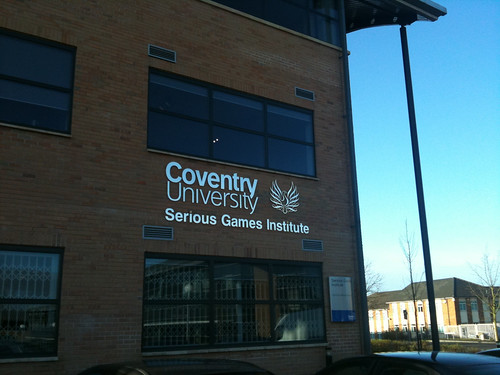On friday I took a trip up to Coventry in the midlands to the Serious Games Institute. It is hard to believe that I have not been up there before as it really is the hub of nearly all the virtual world activity in the UK. I have been to lots of the events remotely, but it aways seemed that when we did events with SGI is timed in ways that meant Roo got to go and represent eightbar. I do however, know lots of the people who both set it up and use it from all the various other speaking engagements and conferences that there have been on virtual world use the past few years. Other virtual events also mean our patch cross, intertwine and build upon one another. SGI is home to projects like Oliver and David’s Shaspa for greener smarter buildings managed in clever and interesting ways with automation and virtual world technology. So going into the tech park at Coventry university and entering the reception felt like home to me.

In the main reception there were a good few demo’s and multiple displays of various proofs of concept and projects. However there was a great piece of news scrolling on the screen that David Wortley (the director of the SGI) had been made a Fellow of the Royal Society of the Arts. I did not get to talk to David about that as he was out of the country, but it is great news. David and I were on the same bill at the Derry Awakening Creative Entrepreneurship event back in March, my first physical event with Feeding Edge.
Whilst at SGI I got to say hi to Sara de Freitas and also to meet up with everyone Vin, Mark and Ollie from Secondplaces.net
Across the way in a large room an project was being demoed and used by a large number of people with Ron Edwards from http://ambientperformance.com/ who, amongst other things, use Forterra Olive for large projects. I will do a more full post on what they were up to once they have released that to the public. It was a very interesting one to see working with a great dynamic.
It was interesting having a chat and catching up on what had occurred around the industry and how the UK was still leading the way in many of the uses of virtual worlds, even if the large US based companies were seemingly claiming the turf. However us brits just get on with things 🙂
So for me this was great to be with so many people who I know get the potential we are all exploring and pushing and it felt I was very much amongst friends, with the great dynamic of support and competition in place at the same time. That horrible made up corporate buzzword bingo description being co-opetition.
Anyway, thanks to everyone for talking and sharing and I look forward to coming up again very soon and working on some more projects.
business
Digital Britain – Let free happen?
I have been listening and nodding away in agreement at Chris Anderson’s Free and reading Don Tapscott’s position on Digital Britain. In particular it was interesting to hear the history of the music industry and how is has shifted since the 1930’s. Each step challenged by the incumbent powerhouse, though the industry flourishing and growing despite that.
I paraphrase part of chapter 3 of
Free: The Future of a Radical Price: The Economics of Abundance and Why Zero Pricing Is Changing the Face of Business
In the 1930’s radio emerged.
Artists were paid for a single live performance, though this seemed unfair when compared to a concert hall of ticket paying audience when in fact it was broadcast to millions.
ASCAP insisted on royalties based on gross advertising revenue of the station at a high rate.
They wanted to raise the rate in 1940 when contract expired, which caused the radio stations a problem.
Whilst negotiations were on more stations started to use recordings as the technology had evolved and now had a use.
The record industry responded by stamping “not licenced for radio broadcast” on records.
Th US Supreme Court ruled if the station bought a record it could play it.
ASCAP persuaded major artists to stop producing records, hence cutting the content flow to the radio stations.
Stations were faced with either crippling royalties, or no content.
So they self organized their own agency BMI
This became a focal point for those niche artists and styles previously ignored by ASCAP.
Country & Western and R&B etc.
These “niche” musicians just wanted exposure so let the music be played for free
Radio then became a prime marketing channel for music not a direct revenue engine
Artists made money from records sales and concert sales and it moved back to live performance again.
With a combination of a smaller royalty formula and the rise of the Disc Jockey the top 40 era emerged. The music industry grew because of this.
Now the industry is about merchandise and live performance in concerts and still thriving.
Now of course we have the ability to both buy digital music at relatively cheap prices, and also for people to share them with one another for free. The powerhouses will say that this will kill music. It will if no one ever pays of course. However then no one will have any music and the human need for that will drive the creation of music. Live performance however still needs to be live, the tech will improve to allow the experience to get closer to the real thing as we see with virtual worlds. It then becomes about being at the event, being part of the event not just being broadcast too. The artists get to perform and get the adrenalin payoff for delivering to a crowd. Money will change hands, people will make a living.
The sands will shift, new patterns will emerge?

Of course piracy is a constant conversation and battle, but if something is good some people will show their appreciation , either by paying, donating, or spreading the word and acting as a salesperson to reach the people who will pay.
I am writing this as a someone who seeks to get paid for what I do, those things are very often about live performance of some sort. Generating ideas, inspiring people, explaining. Equally though lots of people expect that turning up to talk and generate ideas should be free, but they may pay for a “deliverable” some code, documents etc. Likewise much of what I share here is obviously giving away some ideas. Something that traditionally has been regarded (before the ability to share so widely) as something you keep close to your chest. Now blogs and twitter are my radio station playing my records that I create myself in order to help people know what I do, what I think and how I can come and perform for them and build their ideas in emerging tech and virtual worlds.
The various conversations about Digital Britain and clamping down on people worry me greatly. They have elements of the ASCAP example above, though I suppose this sort of restricted practice is needed in order for the industry to flow around it and grow. Having an threat or an enemy brings great resourcefulness. The danger is that the powers that be manage to crack down so much that we set the business innovation back too much.
Where are Apple in virtual worlds then?
Yesterday I was asked what Apple are doing with virtual worlds and related technology. The answer had to be, I don’t know, it would appear nothing specific. It was something I brought up at the 3DTLC conference in washington earlier in the year.
Having tweeted about it and ended up on a Facebook discussion it seemed worth putting some more firm thoughts down here.
I agree that Apple mac consumer hardware, the iphone, ipod, Mac. They also make the operating systems to power those specific pieces of hardware. In doing that they heavily focus on the user experience and giving a smooth experience to users and to developers.
Clearly when we are talking about virtual worlds they can be considered just an application. Opensim servers run just fine on my MBP. The various clients for Second Life work just fine too. So it is great for them to just keep cranking the handle on their base products.

(Photo made using 3dvia app on iphone and 3d model Santa is Mad by Toymaker )
However, the iphone and its recent updates to allow Augmented Reality applications, combined with development tools like unity3d and the number of 3d games such as Star Wars Trench Run is showing that as a mobile platform it is viable to interact with a virtual world app.
So is it likely for Apple to start to help with the same sort of UI polish and standards that it has created for touch applications, or the look and feel of the Mac OS?
Is Apple in a position to create and manage the equivalent of ITunes or the App store for virtual goods and content?
Already the iphone SDK has been updated to allow the delivery of new packaged content within an app, to allow free apps to be unlocked through commerce applications.
So in many ways Apple already has the pieces for us and are starting to use them themselves by creating an App team. The question is, what will Apple do? A few years ago we would not have expected the iPod and iTunes to come from people that made the homebrew original Apple hardware would we?
It will be interesting to see this develop.
Stop press! Kermit comments on Video Conferencing
Many of us grew up accepting the tv based avatars (sorry puppets) that are the muppets. Many of us over here in the UK also use the term “You Muppet!” as a sort of slang joking derogatory line for someone foolish but harmless. The wide world interweb and associated social media has been awash with this muppets video. It is brilliant, but it also has an up to date message at the end.
So next time someone says, ah but can’t we video conference instead, just point them at the end of this video 🙂
Social media is NOT network marketing
I had an unusual business experience the other day. I am not going to trash the company involved, nor the person involved, however I had a meeting about a business opportunity based, apparently, on my significant social media experience and metaverse evangelism.
It turned out that this was not a consulting job, nor even some free advice, and certainly not startup sweat equity.
Instead it turned out to be a “network marketing” opportunity. I sat through the presentation, knowing from the first opening gambit where this was going, and used the experience to observe the selling technique, and to be a little more observant on the mix of actual facts and science blended with emotional pointers to personal greed and aspirational statements.

At the end I pointed out it looked and sounded like a pyramid scheme ( which I was assured it was not as that’s illegal). Of course the answers are there for anyone challenging such a business, at it may have indeed been the best opportunity that I have never taken, but calling it network marketing still feels like a pyramid scheme. The definition of that made me challenge my perception of what we all do across social media. Obviously some people use these channels for network marketing. However where does snake oil, spamming crossover with good moral codes?
It became clear to me that when I am interested in something I will promote it, I will share it and I will help people understand why. However, and this is important to me personally, I do not do that to try and extract cash from my network. I view my network as a varied mix of people who are influenced and influence in equal measures. It is a support mechanism to lead to other business and other interesting avenues of investigation. That mutual support could be said to be what they do in an MLM but they really aren’t that are they?
In thinking that though there is clearly some difference, but also at a certain level of abstraction its the same as any Multi level marketing? I share things, get them passed on, and hope that they come back in a good way. In virtual worlds that was passing on the lessons and opportunities in Second Life initially and then on other platforms. It helped in some small part, make SL’s enterprise demand arise. That experience of growing that type of interest and business through social media and through being in all this together is what comes back to me as the sort of consulting, development and public speaking that I now do to generate further reputation and also money to pay the mortgage as a startup.
The Network Marketing approach seems geared to help others become passionate enough about the product that they persuade others in.
I am, though, still convinced that my personal intent and business ethics have less direct greed, or less apparent preying on others. That may be a naive attitude to some of the more hard nosed business people out there but I think that doing things for the right reason, not solely for the cash, not solely out of pride should be an aim in life, if at all possible. That starts to be a huge moral issue, when is it all right to make enough money that you can than be philanthropic?
For me though, I know that right at the moment I cant see me wanting to partake of any of this network markering gigs, no matter how good I may end up being about it. If was was great at it and lucked out I would be doing so at the expense of others. If I was not then I would just have been suckered in.
Xbox Live concurrency, how many? Are these numbers big enough yet?
It is interesting that in the world of long tail we are still very focussed on how many people are in one place online, or paying attention to one piece of content. Places like Second Life have a good few users, and lots of stats and arguments to be had about how popular it is. It is a container service though that has lots of sub places within it. Those also want to be popular to as many people as possible. All this ends up as the justification to either ignore something and tut, saying yes but its niche isn’t it, or pile into the place in a feeding frenzy of business and advertizing or finally ignore it because its just too popular.
The reality of the networked world is that it is very easy to move around from place to place, jump websites and applications, moving things you need with you. You connect with people that are interested in what you are interested in. We are of course limited on the time and attention we can place on things and those wishing to extract money from us would rather we were in one place to be harvested. I have to yet to work out the boundaries of when something should be worthwhile to look into and consider and be regarded by others as worthwhile.
This was brought into focus by the recent news that something we can consider very mainstream now, the games industry has hit another milestone on one particular platform. That is the number of concurrent users logged into Xbox Live. For those not familiar with it the Xbox 360 console has access to a centralized system so that when turned on or in a game you have access to friends and content. Its a walled garden extranet really, though it starting to reach the out to the wider web. Its concurrency can mean people playing games, or just having the machine switched on. The magic number quoted was 2 million concurrent users that’s a great number, but also a very small one in some respects.
Do we consider that 2 million people at once is not enough? bearing in mind that is not 2 million people all talking to 2 million people at once, not even sharing the same game. Some people might suggest it is not mainstream enough even though over half the population in lots of western countries play games of one sort of another . It is of course nonsense to suggest the games industry is not big, popular and mainstream.
So back to virtual worlds. How many is going to be enough. When we have 2 million concurrent people on one platform or another (and there are platforms that has already happened 🙂 ) do we then get to indicate that this branch of the web is mainstream and then just get on with it?
Being dynamic in virtual worlds is a strength and a weakness
Second Life and Opensim alike share a particular attribute that is not quite as common to many of the other virtual worlds and games platforms. That attribute (well known to anyone who has been in and looked around) is a completely dynamic and potentially ever changing environment. Creating and moving things on the fly either as a user or through programs and scripts means that any space or event can change almost instantly. It is this attribute which means that sometimes you have to wait a little while for new things, like textures or new shapes to start to appear when the world changes around you.
There is a constant debate between this flexibility and the need to keep things locked down, how much dynamic streaming should something do versus highly detailed, preinstalled graphics.
Whilst that debate rages, and bandwidth improves, or we have hybrid video streaming and broadcast services to get around some of the problems we should not forget that whilst in games pop-up (a rendering engine not managing to raw things as fast as you want to see them) can be distracting, yet in a virtual world like second life watching something rezzed from scripts can be fascinating in its own right.
This is a video of one of the many building designers, rather than leave static buildings lying around the vendor boxes let you see dynamically created versions of the building you wish to purchase. In this case these buildings are not that expensive US$20 in some cases less. So you try before you buy, even show other people. Then pay the designer for their work and take a copy of the building with you to your own place.
This examples is on Creations Estate in Second Life one I just arrived at serendipitously.
I still like watching buildings rezz from boxes, it reminds me of the first clubhouse we had on Hursley back in 06.
Remember if you want to Rez you own houses and places you can always come and join Hursley and rent a plot or two.
There is a direct link here and IQ is next door if you are interested in a much larger half sim plot
Second Life Enterprise – A good addition to the mix
Yesterday the enterprise 2.0 conference saw the official release and announcements relating to Second Life Enterprise and of course featuring some preferred content in the form of Rivers Run Red’s Immersive Workspace and more to come via the Work Marketplace. It is interesting to see this happen both at something like an enterprise 2.0 conference and focussed as a packaged product in the way it is.
Back in April 2006 thru to Dec 2006 (which seems a very long while ago now) we said to one another as we (those early eightbars) realised that there was a huge scope for internal corporate communication…. wouldn’t this be great behind our firewall?
By September 2006 (after the first Wimbledon in Second Life) the US based CIO office had realised the potential and a few of us from places not just in the US ended up on that growing project to understand SL and all the other platforms and their implications to an internal corporate audience. This also started to lead to the more commercial based business unit forming, which interestingly is now part of the CIO office according the communications out of IBM.
This journey and the things that happened on the way (good and bad) all form part of the story I share with people in various ways including the in progress book on the subject.
Linden Lab focussing on enterprise and producing a product, however it is priced and packaged is an important further catalyst to this industry, one that those of us in IBM, Cisco, Sun etc. started to generate corporate and public interest in through our patronage. However this is now happening (unlike in 2006) in an era that has very many more potential direct competitors. many have been there for a while but will now be dropping into even more invitation to tender conversations, Proton Media, Forterra Olive, Teleplace, web.alive…. Equally there will be an increasing drive in take up of the hosted and self hosting services based on Opensim (SecondPlaces, ReactionGrid, Rezzable and SimHost ). Other platforms and standards such as Vastpark, or Wonderland for those who want to still explore and drive forward and develop things for themselves and get a step up on the packages. Services such as Venuegen, specialized in providing a particular quick access service also start to take a share of the market.
It is of course a huge market, business/enterprise communication relates to every employee in every company that has any form of electronic or remote communication. Like email, web and increasingly instant messaging and voip and social media in general it is essential business addresses the communication gaps we have generated. All these options may be confusing, but just pick one and get on with it!
I also still expect an actual games company to realize that their middleware and massive scaling and runtime abilities can be applied to a spin off market. So rather that enterprise business trying to figure out how to use games, games will figure out how to use enterprise business. With some of the developments this week too such as Unity3d becoming free to develop with and also Unreal 3 doing the same to some extent the future looks very rosy and very interesting.
However….. remember that the problems and challenges are not wholly technical. We are dealing here with social and cultural change. Something else I have experienced both the good and bad of and happy to share if you need to talk about the implications to your business, industry or life.
Art, U2inSL and experiences in Second Life
My feeds today led me to look at a brilliant YouTube video that is over on New World Notes called Impressions by Willow Caldera. This video is wonderfully shot and shows a the very creative and expressive side of Second Life. It acts as a reminder (probably to those of us who preach about “business use” or who are starting to finally grok it all that there is much much more to all this than a bit of powerpoint and some business dressed avatars. I would recommend popping over to NWN and taking a look.
In following the links I saw this video too on the same channel about the U2inSL Warchild benefit gig.
U2 are back in the news again for using Youtube themselves (as opposed to this U2inSL who are a tribute act). However I still always manage to get U2inSL into any explanation of what this is all about.
There are several reasons for this.
1. Most people know who U2 are they are both part of the establishment and known innovators.
2. People listen to music all the time on the Radio, Ipods etc.
3. Bono is particularly known for charity work too.
Each of those have a way to reach people who don’t yet understand why we are all harping on about virtual worlds. Love or hate U2 it acts as personal conversation rather than a business one.
What happens at the concerts (as you can see from the video) is effectively a tribute act puppet show/impersonation. Yet it also has a crowd of people willing to watch listen and feel part of it. They are all passionate U2 fans, and they have gathered together to raise some real money for charity by collectively listening to their favourite tunes together.
Underlying all that we of course end up with copyright and image rights conversations, but in the case of U2inSL this really is a passionate fan base enjoying feel connected rather than someone making fake gucci bags for a quick buck.
As many of us keep pointing out, engaging and supporting these passionate fans whether you are a band, an author, a manufacturer of widgets is the key to the world today. Where those people happen to be and the way they are choosing to interact with one another is where you need to be joining in. Not a huge capital investment, not masses of PR and spin but just good old fashioned human to human conversation. Twitter, SL, Facebook…. whatever comes next, you just have to be there.
Predator design on Feeding Edge car
Further to my previous post with some Feeding Edge logos splattered over a Subaru, I just used what little graphic design talent I have to create this multi layered rendition of a predator mask. So I now have both a version of the corporate presence and my own merged together on a GT500.

I think it looks pretty good, but then beauty is in the eye of the beholder.

Update: Using the subaru scoop as part of the predator mask 🙂

